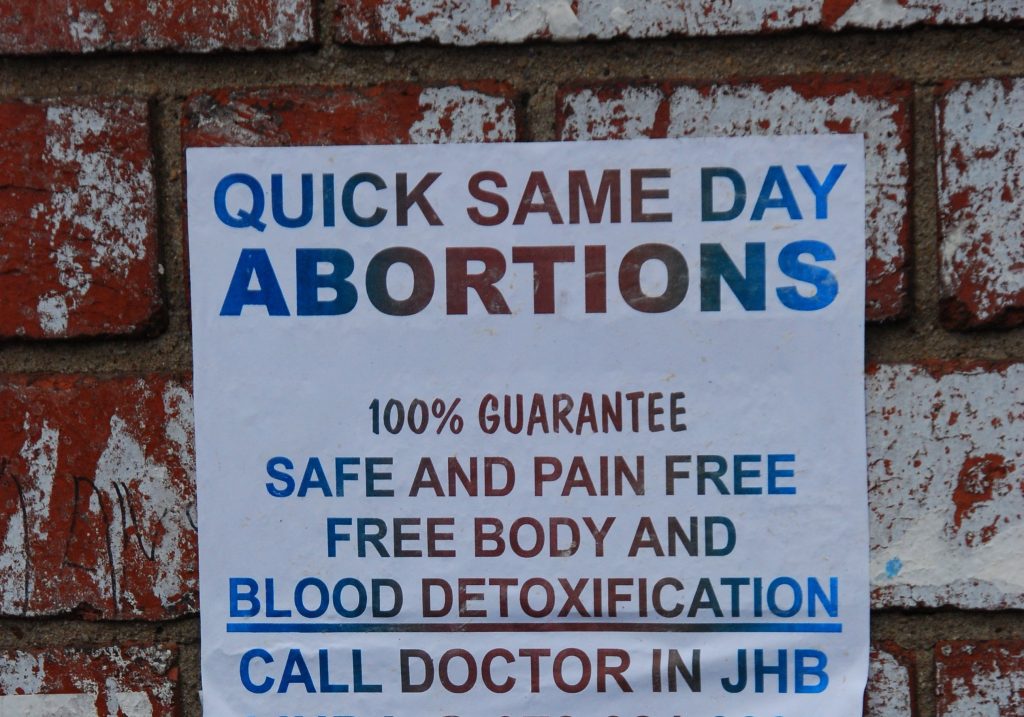When an Arlington County, Virginia, judge ruled that a lawsuit challenging regulations of Virginia abortion clinics could move forward, the Washington Post ran a news report emphasizing that the clinic regulations even mandate the width of hallways. It said that providers worry that complying with the regulations would put them out of business.
The same article talked about how the owner of the clinic who filed the lawsuit is a “woman of very strong faith” who called the judge’s decision “spiritually uplifting.”
What wasn’t mentioned in the cheery report about Falls Church Healthcare Center was what the Virginia Department of Health found when it made a planned and announced inspection of the clinic in August 2012.
As reported in a 65-page document, the facility was found to be blood-splattered and failing to comply with even basic sterilization procedures. Again, this was after being told when to expect a visit from health inspectors.
The inspectors observed that two blood collection tubes, designated as “clean and ready for use”, actually had a “dark reddish substance” where the tube for blood collection attached. A staff member said that the cleaning process for these tubes is to run them under water and then soak them in alcohol at the end of the day, but not between patient uses. When the inspectors pointed out the substance, a staff member said, “That looks like blood. They aren’t clean.” So the staffer ran them under water and said the “blood” was gone.
There was also dried blood of various colorations on the foot/leg support of the procedure table and the metal support under the padded area and the metal base of the procedure table itself. A procedure room was reported as ready for the patients scheduled that day, but observation revealed visible dried blood on the metal joints that connected the metal leg stirrup/supports. There was also dried blood splatter in the “Wet Lab”/Dirty scrub room, on the swing door to a second procedure room, the door jamb to the same room and the wall above the freezer. Two pathology containers were contaminated with blood, and clean equipment was put in contaminated areas.
A sponge used to clean blood splatter was kept on a utility sink, and a staff member reported that the cleaning method for the sponge was to rinse it under water. The list of infractions goes on and on. The clinic was found to have, according to the group that filed Freedom of Information requests to get the reports:
- No bylaws
- No records obtaining criminal background checks of employees
- No policy to report violations to the appropriate Boards of the Health Professions
- No records for verifying that contractors/employees meet personnel qualifications
- No complaint logs
- No policy on infection prevention training
- No procedure for assuring that employees with communicable diseases are ID’d and prevented from transmission to others
- No policy for reporting disease outbreak
- No record of patient/staff/visitor deaths & no policy on how to report deaths
- No record of preventative maintenance on equipment or policy for maintenance
And that list doesn’t include the problems with oversight of narcotics or other serious drugs.
This information came from just one clinic. Virginia health inspectors filed reports on 20 clinics after Virginia’s General Assembly voted in 2011 to regulate abortion clinics like other outpatient surgical centers. These regulations required clinics to meet standards in record-keeping, building design, and infection control. Prior to the 2011 change, clinics were treated like doctor’s offices and not subject to inspection.
What’s fascinating about these reports is that while the Family Foundation of Virginia was able to obtain them by filing a FOIA request, the media are rather dramatically disinterested in them.
It’s one thing for media — a group that normally loves investigating controversial industries — to not to run their own investigations about abortion clinic safety. But it’s entirely another issue to ignore or otherwise cover up the investigations done by a state agency. It’s not that the abortion clinic regulations haven’t been newsworthy. A search for the words Virginia, abortion, clinic and regulations at WashingtonPost.com yields 854 results. But if there was even one piece about how clinics such as Falls Church Healthcare Center fared, I didn’t find it. Instead of stories about what the inspectors found at clinics that were expecting them, readers were treated to highly politicized pieces about unnecessary hall widths and the extremism of pro-life activists.
And about those hall widths
Whenever legislators attempt to strengthen oversight of abortion clinics, opponents usually focus on one thing in particular: the regulation of hallway widths.
“Opponents mocked the idea that the architectural standards would actually translate into better health care,” the Washington Post reported, after specifically citing “wider hallways and doorways.”
Planned Parenthood officials in other states have said they are outraged by hallway regulations. Betty Cockrum, executive director of Planned Parenthood of Indiana, told JCOnline.com, “At no point does the width of doorways have any bearing on the medical treatment that’s being administered.”
RHRealityCheck, an abortion rights site, called the hallway regulations “onerous,” a charge frequently parroted by the media.
Regulating hallway width does seem silly. Why in the world would anyone who cared about women’s health and safety want to regulate the width of hallways at abortion clinics?
To answer that question, let’s revisit the Grand Jury Report investigating Kermit Gosnell, an abortion doctor in Philadelphia. Unlike most sensational serial murder trials, Gosnell’s was not well covered by the media. In fact, most media outlets had to be flat-out shamed into covering it after massive public outcry. But the long and the short of it is that Gosnell was charged with eight counts of murder, 24 felony counts of illegal abortions beyond the 24-week limit, and 227 misdemeanor counts of violating the 24-hour informed consent law. He was eventually convicted on three of the murder charges related to some of the babies he delivered before snipping their spines with scissors, and found guilty of involuntary manslaughter in the overdose death of an adult patient. He was also convicted of 21 felony counts of illegal late-term abortion, and 211 counts of violating the 24-hour informed consent law.
But we were talking about hallways, right?
The adult patient who died under Gosnell’s care was Karnamaya Mongar, a 41-year-old refugee from Nepal. Part of her death, it turns out, was due to paramedics’ inability to negotiate hallways at the “Women’s Medical Society” that Gosnell ran. From the Grand Jury Report:
[T]here might have been some slim hope of reviving Mrs. Mongar. The paramedics were able to generate a weak pulse. But, because of the cluttered hallways and the padlocked emergency door, it took them over twenty minutes just to find a way to get her out of the building.
The Grand Jury account of her abortion and ultimate death reads like an explanatory defense of “onerous” abortion clinic regulations — staff made her sign forms she could not read. Her medication was delivered in an unmonitored and unrecorded fashion. Medical equipment that could have saved her life was not working properly. The poor records and training of staff, along with deliberate downplaying of the problem, meant that hospital doctors never knew what they were dealing with.
And it’s not like Karnamaya Mongar is the only patient in recent memory requiring emergency evacuation from an abortion clinic. One pro-life group has been tracking some of the emergency calls placed by some Planned Parenthood clinics since the Gosnell Grand Jury report was issued. A few months ago they’d written about more than two dozen of them.
When Gosnell’s clinic was finally raided, it wasn’t because of “onerous” abortion clinic regulations. According to the Grand Jury report, “In the end, Gosnell was only caught by accident, when police raided his offices to seize evidence of his illegal prescription selling.”
But when the police got there, they found conditions so horrific that they summoned ambulances to pick up waiting abortion patients. Once again, emergency personnel “could not maneuver stretchers through the building’s narrow hallways to reach the patients.”
The Grand Jury said:
Clinics must have doors, elevators, and other passages adequate to allow stretcher-borne patients to be carried to a street-level exit. Gosnell’s clinic, with its narrow, twisted passageways, could not accommodate a stretcher at all.
So what was that one Planned Parenthood official saying again? At no point does the width of doorways have any bearing on the medical treatment that’s being administered? Karnamaya Mongar would say otherwise, if she were able to.
What we mock when we mock regulations
Hallway widths are just one of the architectural standards required for clinics serving women such as Karnamaya Mongar. They are supposedly the most ridiculous of the regulations facing Virginia’s previously uninspected clinics. But the fight to avoid such regulations tells us something about America’s abortion regime and the media that support them.
Problems at abortion clinics are routinely downplayed, ignored, or excused. The abortion rights mantra about how abortion should be “safe, legal and rare” frames the way pro-choice activism is presented in the media. Which is to say that it is always positive, always fluffy, always light. Remember the clinic owner at the top of the story? The newspaper hid the actual results of state inspections of her clinic … in a story about state inspections of her clinic … so that readers could be told she was a woman of “very strong faith.” Telling.
When activists fight safety regulations, as they have in Ohio, Virginia, and Texas this year, there is little push back from the media. Sometimes it’s the opposite of push back. Campaign finance regulators would be forgiven for considering the recent media coverage of state Sen. Wendy Davis (D-Texas) as an in-kind contribution to her political campaigns. Rather than discuss safety regulations at abortion clinics in Texas, rather than discuss late-term abortion, rather than point out how American abortion laws are far laxer than laws even in Europe … we were treated to stories about her shoes. And then more stories about her shoes.
Even if you don’t consider the life of the unborn child targeted in an abortion, and only the life of the mother who is undergoing the procedure, abortion carries risk. For an industry and media that claim to care about fighting against a “war on women,” is having hallways that gurneys can pass through really an insurmountable barrier?
Much of the Gosnell Grand Jury report was devoted to how state and local officials allowed the situation at Gosnell’s clinic to happen. “We discovered that Pennsylvania’s Department of Health has deliberately chosen not to enforce laws that should afford patients at abortion clinics the same safeguards and assurances of quality health care as patients of other medical service providers. Even nail salons in Pennsylvania are monitored more closely for client safety,” the report said.
When BuzzFeed listed a dozen or so “Horrifying Passages From The Kermit Gosnell Grand Jury Report,” this was one of them:
They described blood-splattered floors, and blood-stained chairs in which patients waited for and then recovered from abortions. Even the stirrups on the procedure table were often caked with dried blood that was not cleaned off between procedures.
Hopefully none of the Virginia abortion clinics being inspected under the new regulations would reach Gosnell-level of horrors, even if they also feature blood spatters and caked blood on procedure tables and elsewhere. But it is worth asking what Virginians think is appropriate oversight. Until the media begin reporting on what announced inspections have found, it will be difficult to have an informed conversation about whether they should be strengthened or weakened.



